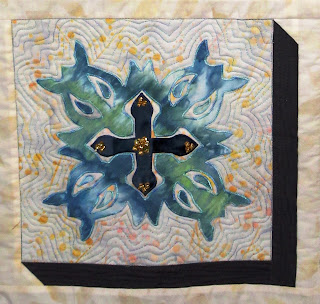Selvage edges can be used in piecing for interesting design and effect in a block or project. After purchasing your yardage, check out the selvages to see if you want to save them from the bin. Rotary cut at least 1" into the print so you will have enough to sew onto and leave for interest.
There are a few books and articles written on this technique. I have purchased the book by Riel Nason entitled, " Modern Selvage Quilting" published in 2016. This book explains her method of piecing and 15 projects to make.
About 3 years ago, I made these mug rugs and blogged about them, however since then the post is lost into the ether. So, if you're interested, I will try to explain the method of creating them. You will want a wide variety of selvage strips to choose from in varying widths. There are lots of choices to consider like adding just color bubbles, text, or blanks. For the size of your foundation square, requisition your strips and set them in the order you want to sew them. Decide if you want the orientation to be straight across or at a diagonal.
Cut your foundation fabric from muslin. These are 5 inches square. Cut a backing fabric from a contrasting print.
Lay your first piece in one corner. Sew a straight stitch from edge to edge following the line between the printed edge and the text edge. Lay your second strip over the top edge of the first by at least 1/4" for the seam allowance.
Sew down the second strip close to the edge.
Be sure to leave at least 1/4" seam allowance underneath.
Sew down the third strip close to the edge leaving as much print as you desire from strip 2.
Flip down and trim away the excess leaving the seam allowance for strip 2.
Continue adding strips until your foundation square is completely covered.
Now you will trim away the strips hanging off the edges of the foundation square.
Stack the batting, backing and your pieced square together and sew around leaving an opening to turn. Press and close the open edge. Quilt as desired.
I usually edge stitch very close and then follow the diagonal edges to finish.
Here is the reverse side of the 4 mug mats.
They would make a nice house warming gift or hostess gift.
This is my next selvage edge project. I used mostly modern fabrics and limited color choices.
Happy sewing and enjoy! :o)






























.jpg)